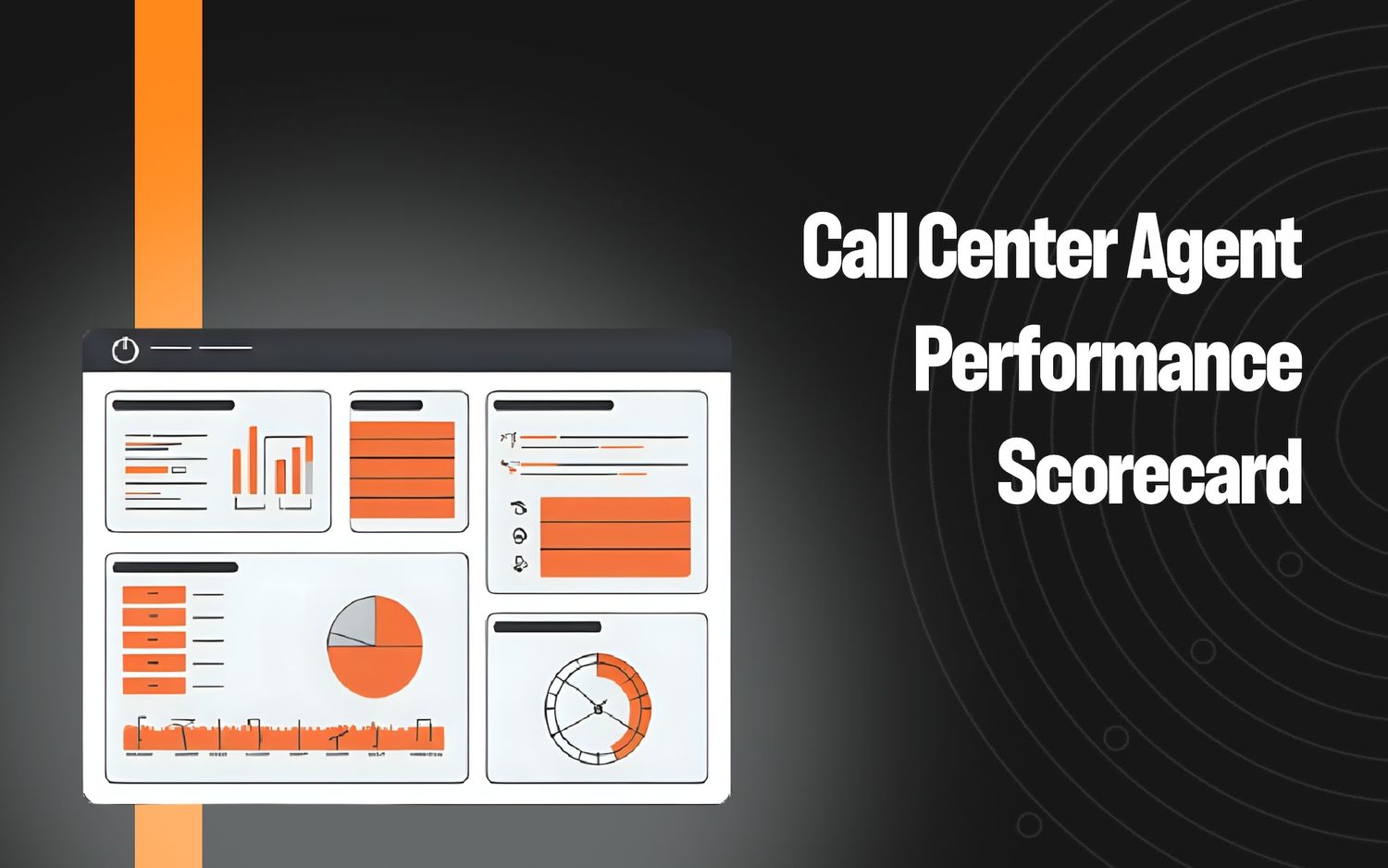6 Best Call Center Analytics Software (2025 Comparison)

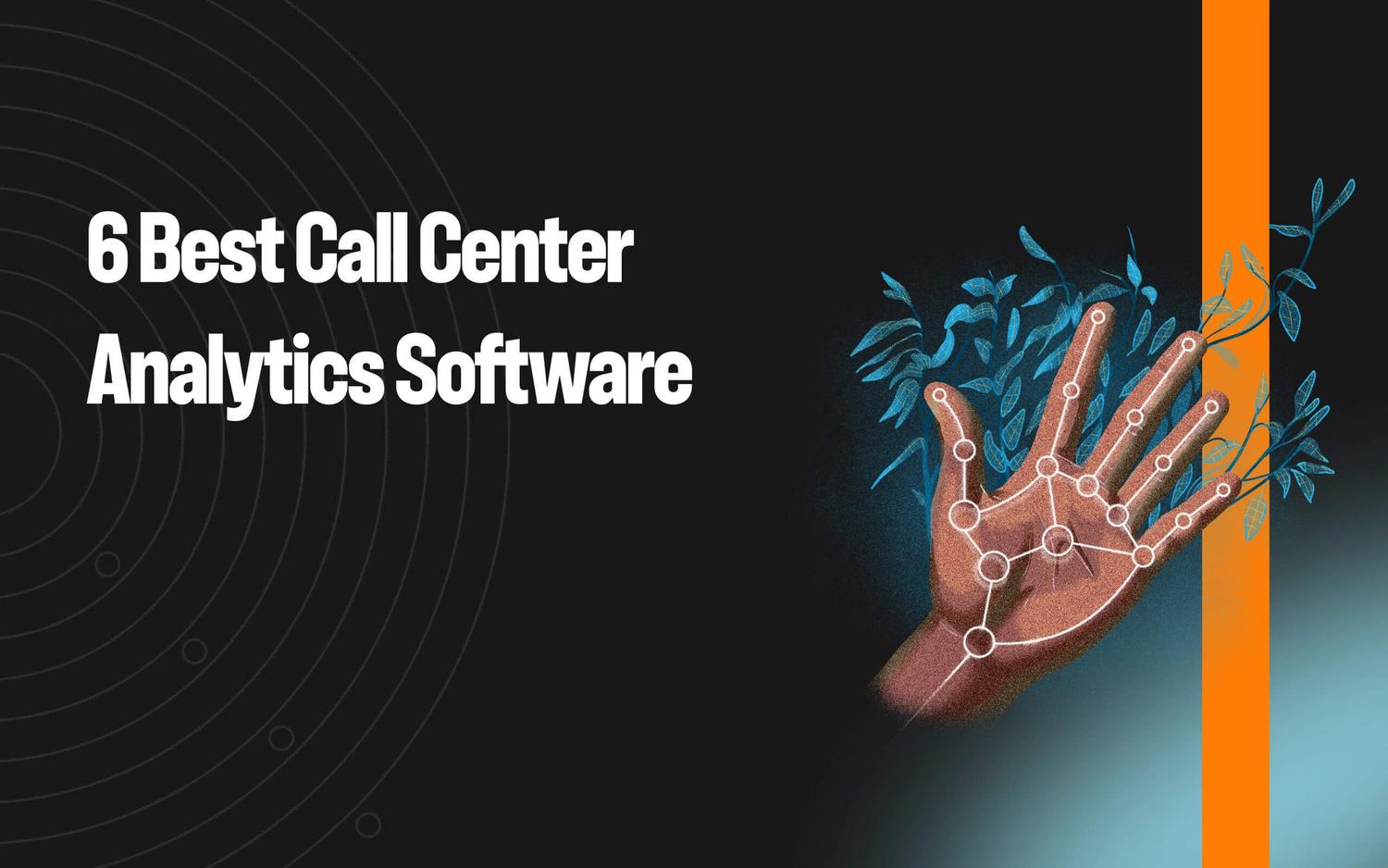
Call center analytics refers to the statistics and data that call centers gather to monitor and improve their performance, such as:
- First call resolution
- Agent utilization rate
- Average speed to answer
- Abandon rate
- Average call lengths, etc.
The underlying goal behind measuring these metrics is to improve:
- The customer experience
- Agent performance
- Sales (such as upselling, cross-selling, etc.)
- Call efficiency and resolution
- Workforce management
Call center analytics software (often used interchangeably with contact center analytics software) is a rather broad category of tools that gathers data points around service agents’ interactions with customers, not only across calls but also through other service channels like self-service chat and email.
These tools come in two tiers: a basic tier that tracks interactions between agents and customers and a more advanced tier of modern tools that offers speech and predictive analytics.
To help you evaluate customer analytics software, we’ll explain the different tiers and what each offers. Afterwards, we’ll present six contact center analytics solutions, starting with our own product, Level AI.
Level AI extracts a wide range of analytics from unstructured omnichannel customer data, including call center data, QA reports, and valuable business insights such as customer and product analytics.
5 Types of Call or Contact Center Metrics
Call center analytics is a broad category encompassing different types of metrics. Most software products on the market today track metrics that fall into at least a few of these types, which we describe below.
Interaction Analytics
These kinds of metrics can be described as foundational to any contact center, as they help gauge the basics of how much and how fast customer queries are being answered. As a result, they’re generally offered by all call center analytics software.
Examples of interaction analytics include average response times, abandonment rates, resolution times, average handle times, and number of call transfers.
Omnichannel Analytics
Omnichannel analytics offers a broader and more integrated approach to understanding customer interactions than single-channel analytics, such as phone and email.
Typical metrics of omnichannel analytics include channel utilization, first contact resolution (FCR), and interaction volumes across channels.
Customer Satisfaction Analytics
These analytics attempt to gauge customer satisfaction via post-conversation surveys (e.g., surveys that agents send to customers after a phone call, email exchange, or chat interaction).
Customer satisfaction analytics typically measure such indicators as NPS, CSAT, and Customer Effort Score (CES).
Speech and Sentiment Analysis
Speech and sentiment analysis provide advanced measurements related to the content of conversations, enhancing quality assurance and customer experience. Speech analytics uses technologies such as natural language processing (NLP), machine learning, and artificial intelligence to automatically transcribe, monitor, and analyze verbal interactions between customers and agents.
Metrics in this area include sentiment analysis, speech-to-text conversion, keyword and phrase detection, and topic classification.
Predictive Analytics
Predictive analytics use AI to identify patterns and trends in customer interactions. Predictive models can flag conversations that are likely to violate compliance standards, allowing managers to take proactive steps to address these issues.
Additionally, predictive analytics show trends in agent performance, ensuring that training programs are tailored to address specific skill gaps and improve overall service quality.
These metrics help contact centers anticipate future needs, optimize operations, and make data-driven decisions to improve performance and customer satisfaction.
What to Look for in Call Center Analytics Software
In light of these different types of analytics, we believe it can be useful for companies evaluating options to consider call center analytics software in two tiers of features:
The first tier includes fundamental features that are standard across most products:
- Interaction analytics
- Omnichannel analytics
- Customer satisfaction analytics
The second tier represents the cutting edge of today’s contact center analytics solutions and can distinguish outstanding solutions from the rest:
- Speech analytics
- Predictive analytics
Products offering second-tier features typically also include those in the first tier and sometimes automate aspects of these, such as using NLP to transcribe and analyze call recordings to identify the reasons behind longer handle times.
All in all, second-tier features are useful because they:
- Give you deeper insights into customer interactions.
- Help you to automatically detect issues before they escalate.
- Help you tailor coaching and training programs for specific skill gaps.
Here's our list of six call center analytics products with both feature tiers:
1. Level AI
100% Intent Recognition in All Customer Interactions
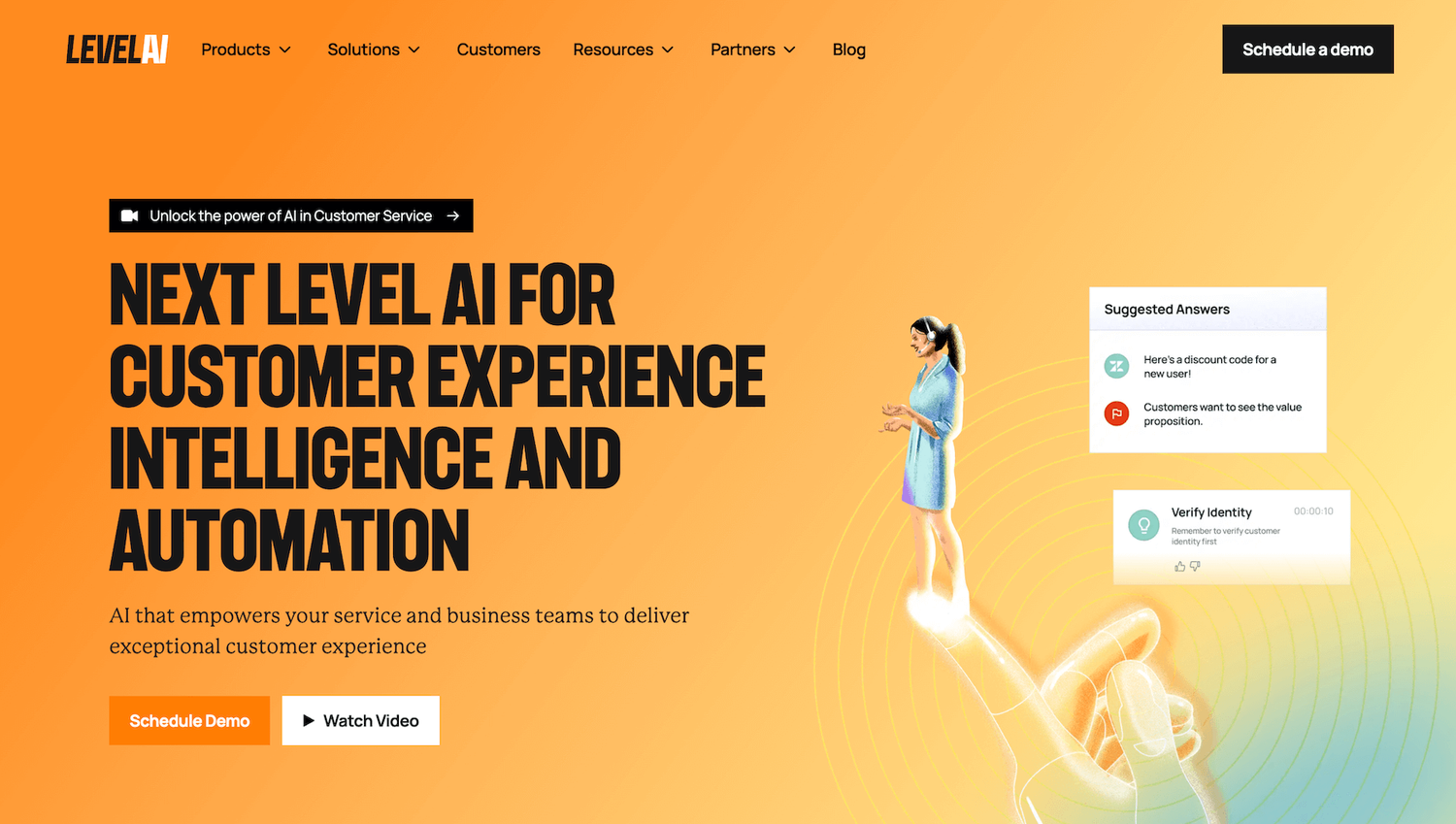
Level AI is a customer intelligence platform that analyzes the intents and meanings expressed by customers and agents in all contact and call center interactions.
Our platform offers the full range of analytics feature sets we described above to give you a holistic and accurate picture of interaction dynamics, allowing you to visualize broad trends and patterns.
It also reveals the sentiment and the true emotional state of your customers, enabling you to tailor responses and train your agents more effectively. Additionally, it provides deeper insights into agent performance and highlights areas for improvement.
In the following sections, we highlight Level AI’s most relevant call center analytics features.
Intent Recognition with Semantic Intelligence
Our Scenario Engine uses a semantic intelligence model to recognize intent — which we classify as scenarios — in conversations. We recognize certain phrases, either spoken or written, as hints of scenarios and indicate these by tagging them in the text with conversation tags.
For example, the Scenario Engine interprets statements a customer might say, such as, “Can I get a refund for my ticket?” and “I want to reschedule my travel dates,” as corresponding to the Itinerary Modification or Cancellation scenario.
Recognizing and indicating scenarios via natural language understanding is more effective than using keyword-based systems, which are still used by many analytics tools for conversational analysis. These systems might miss certain nuances of human speech hinting at a particular intent.
For instance, an online travel agency that defines a number of keywords to represent the scenario of Itinerary Modification or Cancellation would be able to recognize the correct intent in phrases like “I need to change my flight.”
But a keyword-based system could easily flag false positives in phrases like, "I don't need to change my flight now," just because it includes the keyword "change my flight".
This is because keywords often fail to capture subtle meanings behind phrases, such as when a customer doesn’t need to change their itinerary because their plans haven’t changed or the existing schedule is still suitable.
When setting up Level AI, you can define these scenarios yourself and associate them with example phrases to train the AI to recognize these situations, as shown in our “Shirt Quality Complaint” example below:
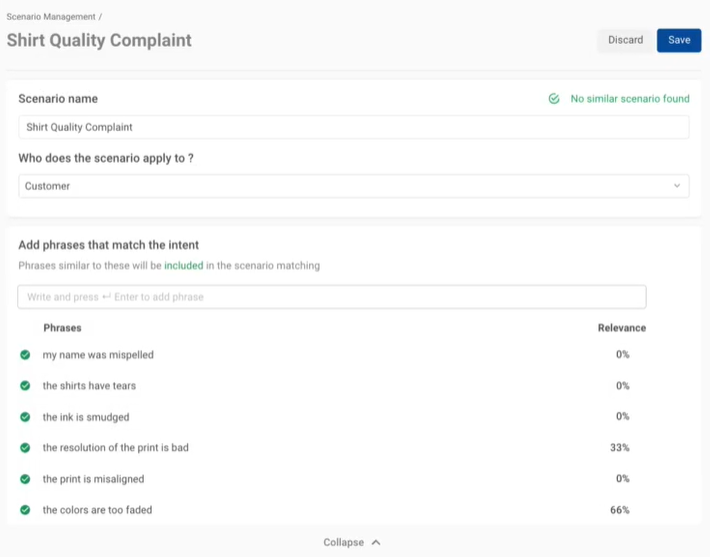
Using these example phrases, our AI generates additional conversation tags to indicate meaningful text that signals one of your defined scenarios.
A conversation can contain multiple such tags, which our system indexes and makes searchable to allow you to later pull up all conversations where a certain scenario was expressed:
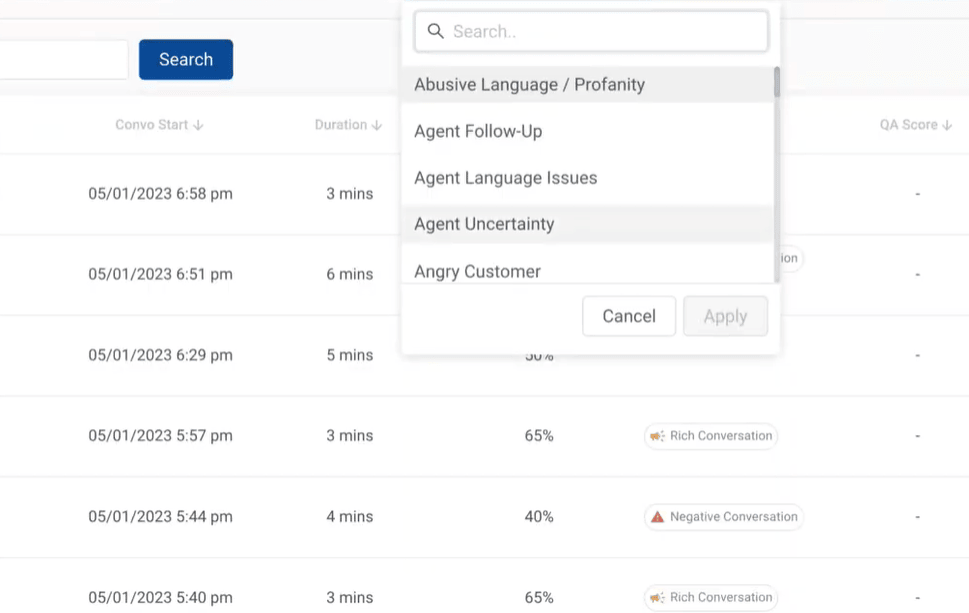
These tags allow you to sample your call center’s conversations more effectively than keyword searches, helping you identify trends and address common issues proactively.
Automatic Call Dispositioning
Besides identifying intent, our Scenario Engine auto-categorizes calls into categories and subcategories based on the topics discussed, saving agents time by eliminating the need for manual categorization.
Our semantic intelligence model accurately recognizes words and their meanings, even when phrases are expressed in vastly different ways.
For example, if a customer says, “I want to upgrade my plan,” or “How can I get more calling minutes on my account?,” our system will categorize both interactions under the appropriate category, such as "Account Upgrades."
This ensures that all calls are consistently categorized, leading to more accurate reporting and analytics.
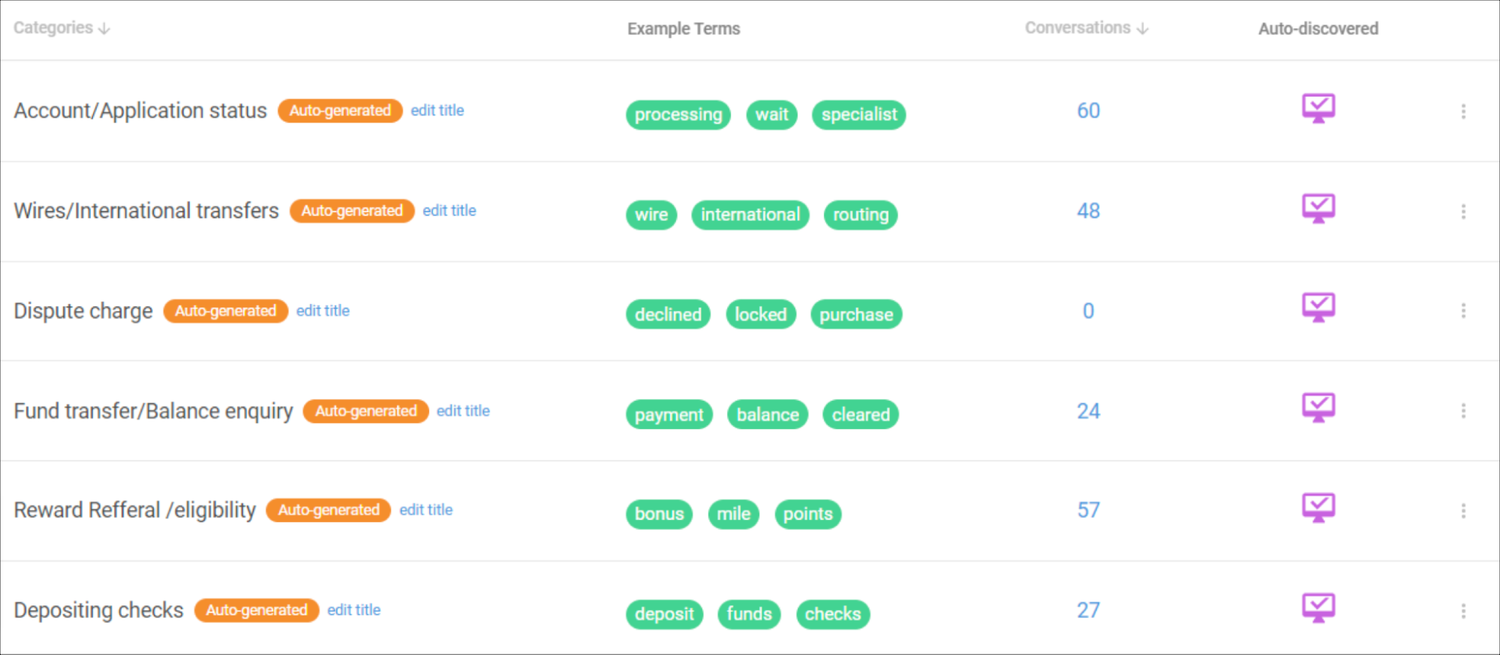
This automation is beneficial given that human error can sometimes creep into dispositioning. For example, agents normally do call dispositioning after a conversation, manually searching through a tiered tree of topics and subtopics to find the correct category, where fatigue and stress can sometimes contribute to wrong selections.
The categories for dispositioning are automatically generated by our platform using natural language understanding. You can also add your own categories by providing example phrases. Additionally, we show phrases from past calls that are near misses but don’t quite match the category. You can choose to add or reject these matches based on how closely they align with your defined category. This process helps fine-tune the AI model for your business.
Categories appear at the top right of all conversations that you open in the dashboard:
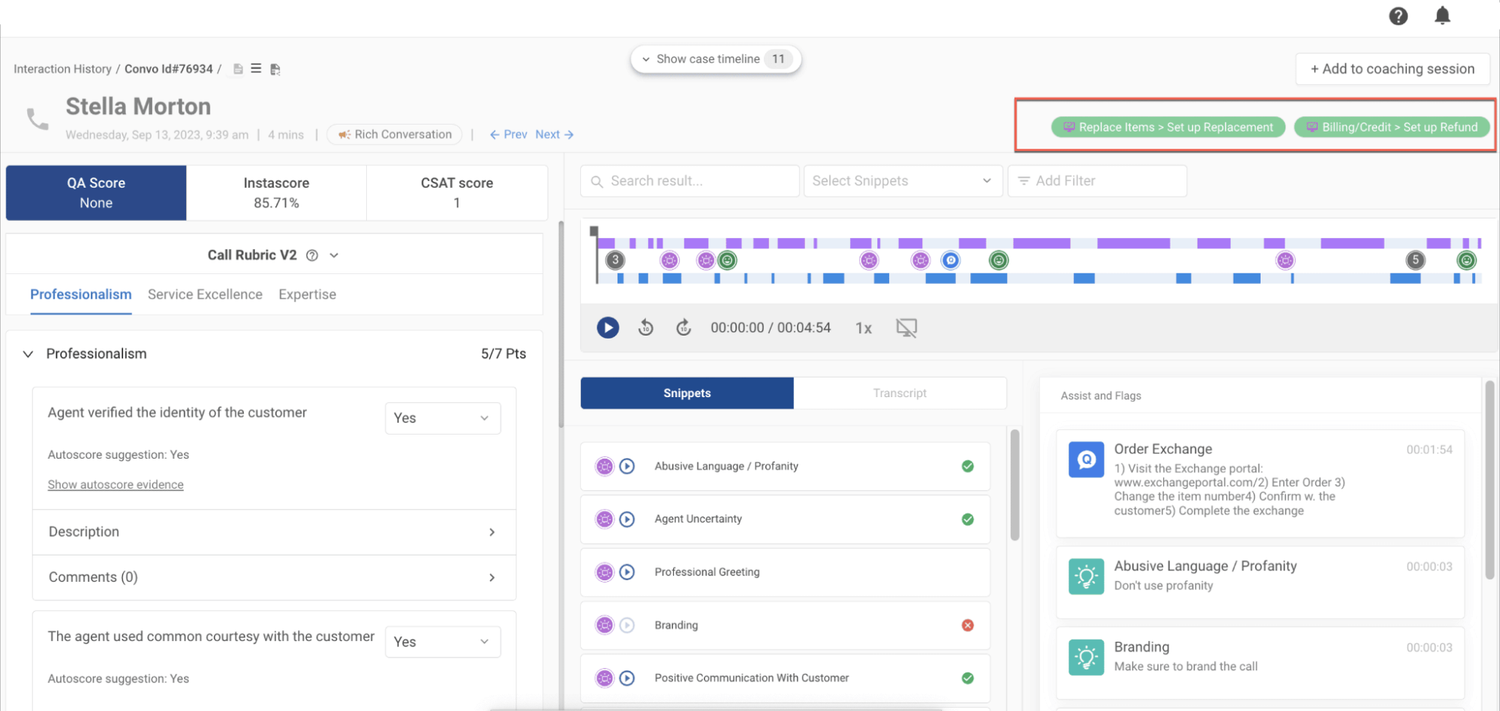
Call Sentiment Analysis
Sentiments can be expressed in various ways during a conversation, and often, a single conversation contains different sentiments throughout.
For this reason, we assign an overall sentiment score depending on when sentiments were expressed. To calculate the score, we assign different weights to various sentiments depending on when they’re expressed in the conversation. This is because, for example, a customer might express a positive sentiment at the start of a conversation, but as this progresses and the issue remains unresolved, their sentiment may shift to frustration or disappointment.
Overall, the sentiments expressed at the end of a conversation have more significance than those occurring at earlier times, and so we assign a higher weight to those occurring at the end.

Besides providing an overall score, we automatically tag moments when sentiments are clearly expressed with searchable sentiment tags, which can later be used for sampling and reporting on sentiment-related dimensions.
Auto Scoring Customer Calls and Agent Performance
An important aspect of interaction analysis is understanding how well your agents perform with respect to goals and rubrics, e.g., “Did the agent maintain a positive and professional tone throughout the conversation?”
Normally, rating agent and customer interactions in this way falls under the purview of QA, which typically does this manually and randomly, managing to review only 1%–2% of total calls.
LevelAI can InstaScore 100% of interactions based on a particular rubric, allowing managers and QA staff to immediately assess the quality of a conversation and filter these results for coaching or performance reporting.
The InstaScore number itself is expressed as a percentage against a user-defined rubric and links to evidence for its assessment.
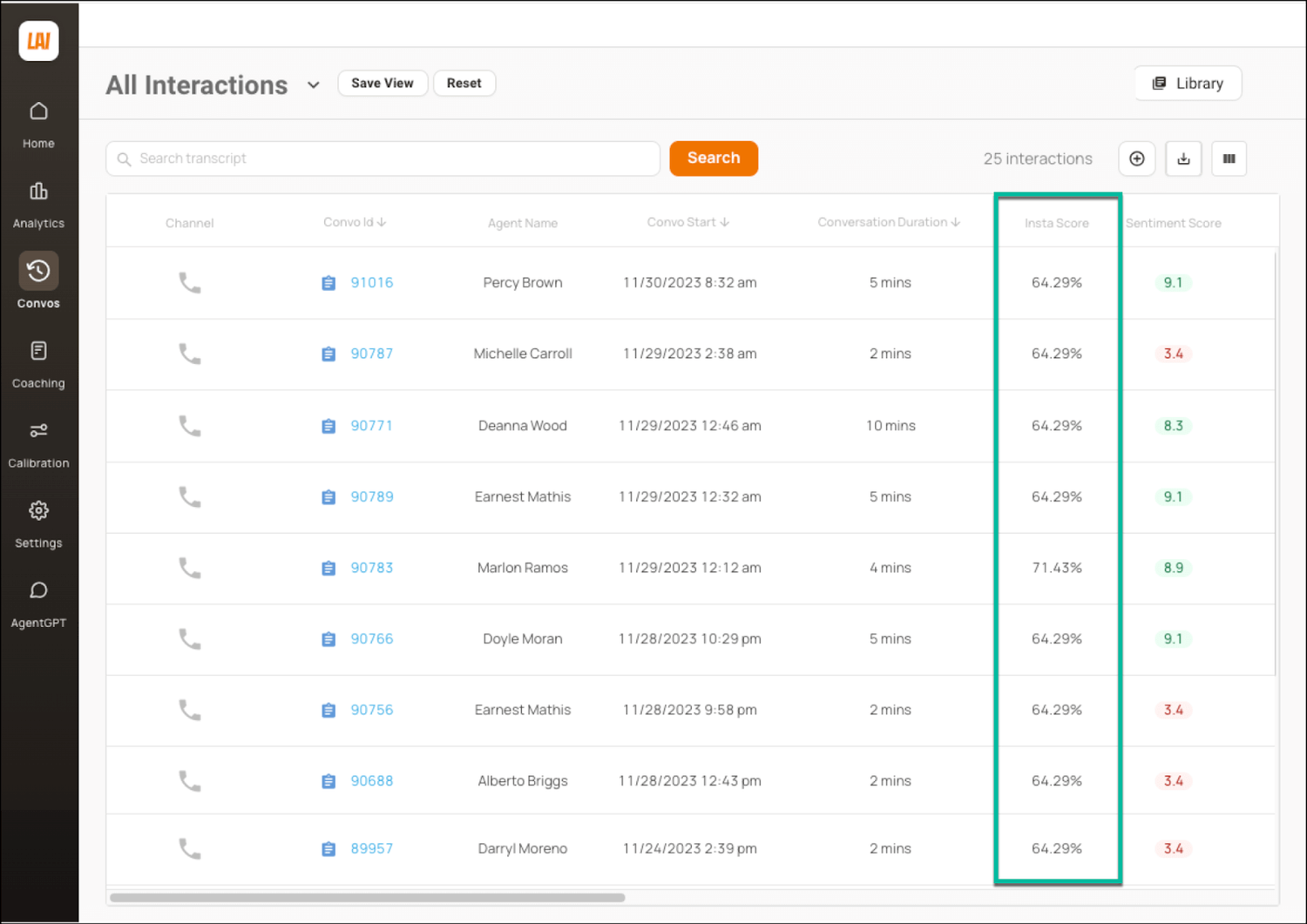
InstaScoring everything allows you to sample interactions far more effectively than manual alternatives. It provides an at-a-glance indication of conversations that merit further scrutiny (e.g., an agent failing to follow the prescribed script during a call).
Auto Summarization and Resolution Tracking
Another area where call center analytics can improve QA is by providing an instant and clear picture of the status of an issue’s resolution. This helps you understand the effectiveness of your customer support and clarify areas needing improvement while highlighting whether the customer or agent needs to follow up on incomplete tasks.
Our platform auto-summarizes calls, allowing managers to quickly see the topic of each conversation and its resolution status:
- Primary Reason — The main purpose of the call.
- Actions — A summary of the agent’s actions taken to resolve the issue.
- Resolution — The status of the resolution. Our platform’s semantic intelligence interprets the conversation from the customer’s perspective, helping you assess your contact center’s resolution rate.
- Follow-Up Actions — Whether any follow-up actions are required from the agent or customer.
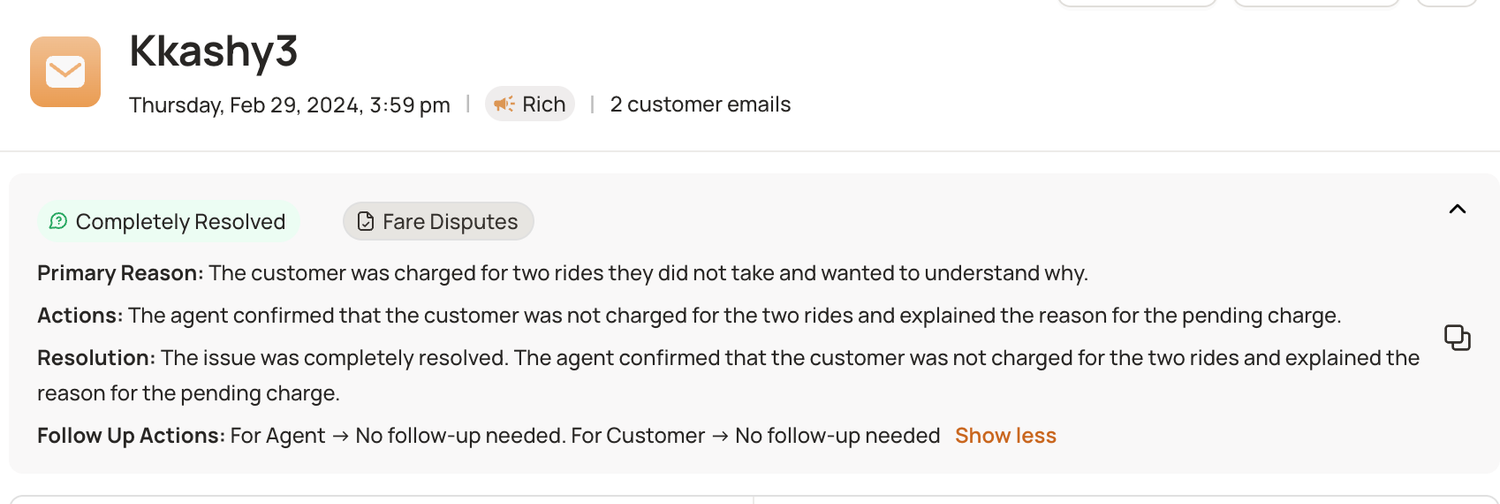
Leveraging Call Center Analytics for Agent Coaching
Analytics derived from call data can facilitate the work of coaches and trainers — providing a clearer picture of agent performance and enabling more efficient sampling of conversations to identify opportunities for improvement.
An example of using analytics to pinpoint issues is Level AI’s InstaReview, which parses all conversations and highlights unusual patterns with color-coded labels. This includes indicators such as low CSAT scores or a high number of non-follow-ups.
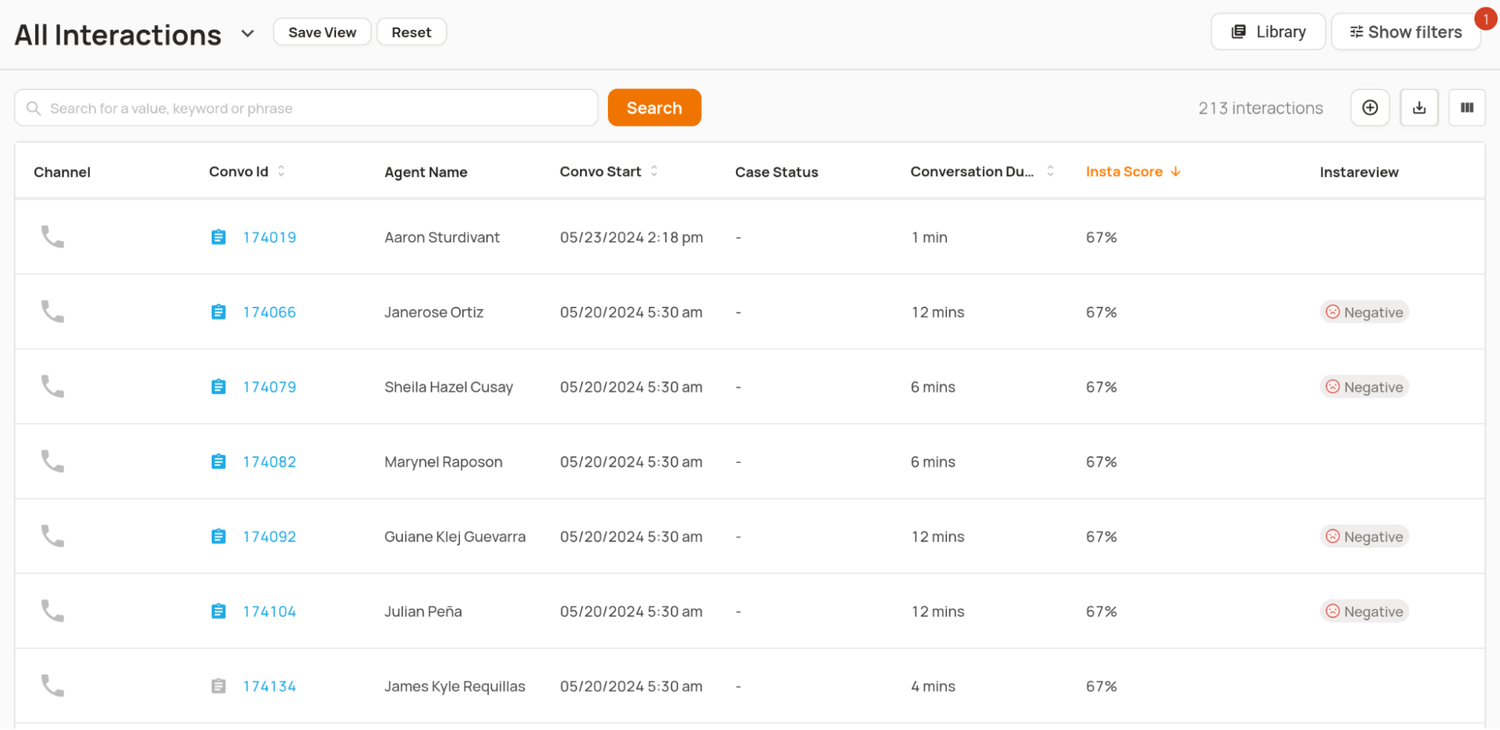
Analyzing all conversations and automatically tagging them saves time and effort compared to manually sampling calls to identify, for example, negative patterns.
As with all types of tags on the platform, InstaReview tags are filterable and searchable, allowing you to more efficiently select calls of interest.
In addition to InstaReview, you can also give agents access to their coaching dashboards, which provide analytics for their conversations.

Measuring Customer Satisfaction from Voice of the Customer (VoC) Insights
VoC metrics like CSAT, NPS, FCR, and customer retention rate offer a holistic view of customer satisfaction and business performance, as they are collected directly from customer feedback.
Such metrics help organizations identify root causes of customer dissatisfaction and recurring issues, which in turn inform targeted improvements in processes and training.
Our AI analyzes all conversations, detecting patterns of issues directly from the calls and highlighting them on a single dashboard, eliminating the need for surveys. In addition to standard metrics like CSAT and FCR, we identify patterns that are unique to your customer interactions, which you might not have previously noticed.
Examples of VoC insights might be patterns of customer complaints (e.g., “Issues with wire transfer” or “Trouble managing payments”). Our system categorizes and indicates these as actionable insights, which can be included in reports and visualized as trends over time, giving you a clearer picture of performance.
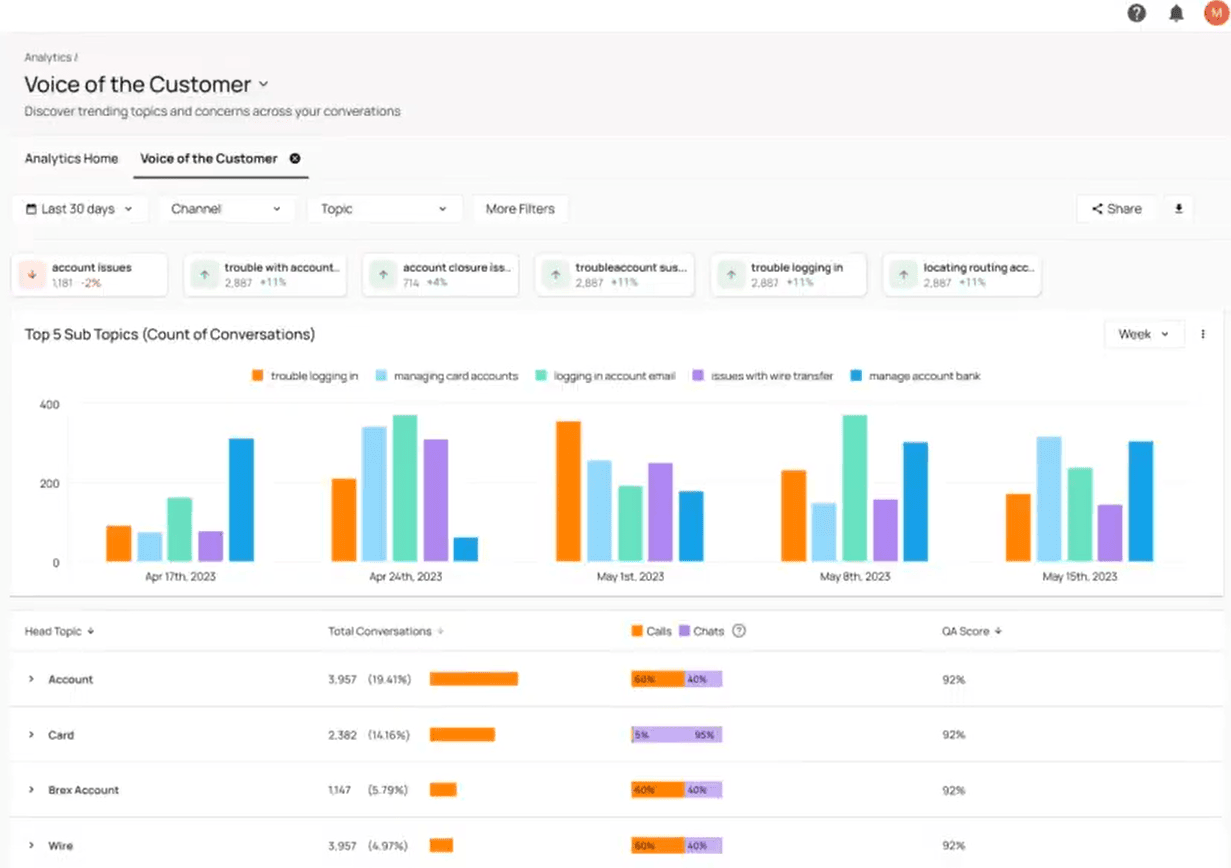
An example of actionable insight is identifying a consistent pattern of providing incorrect or inconsistent information about a product feature or policy, which reveals training gaps within your customer service team.
Comprehensive Reporting from Internal and External Sources
Any software providing contact center analytics should offer extensive features that allow you to:
- Track the necessary metrics to address critical questions about your customers and your organization’s performance.
- Define and customize the layout of reporting dashboards as needed.
- Import data from both internal and external sources and integrate it effectively.
Our platform provides a Query Builder for you to design and customize your own reports, along with an API allowing you to import and integrate data from external sources, such as from your knowledge bases, CRM, and advanced analytics tools:
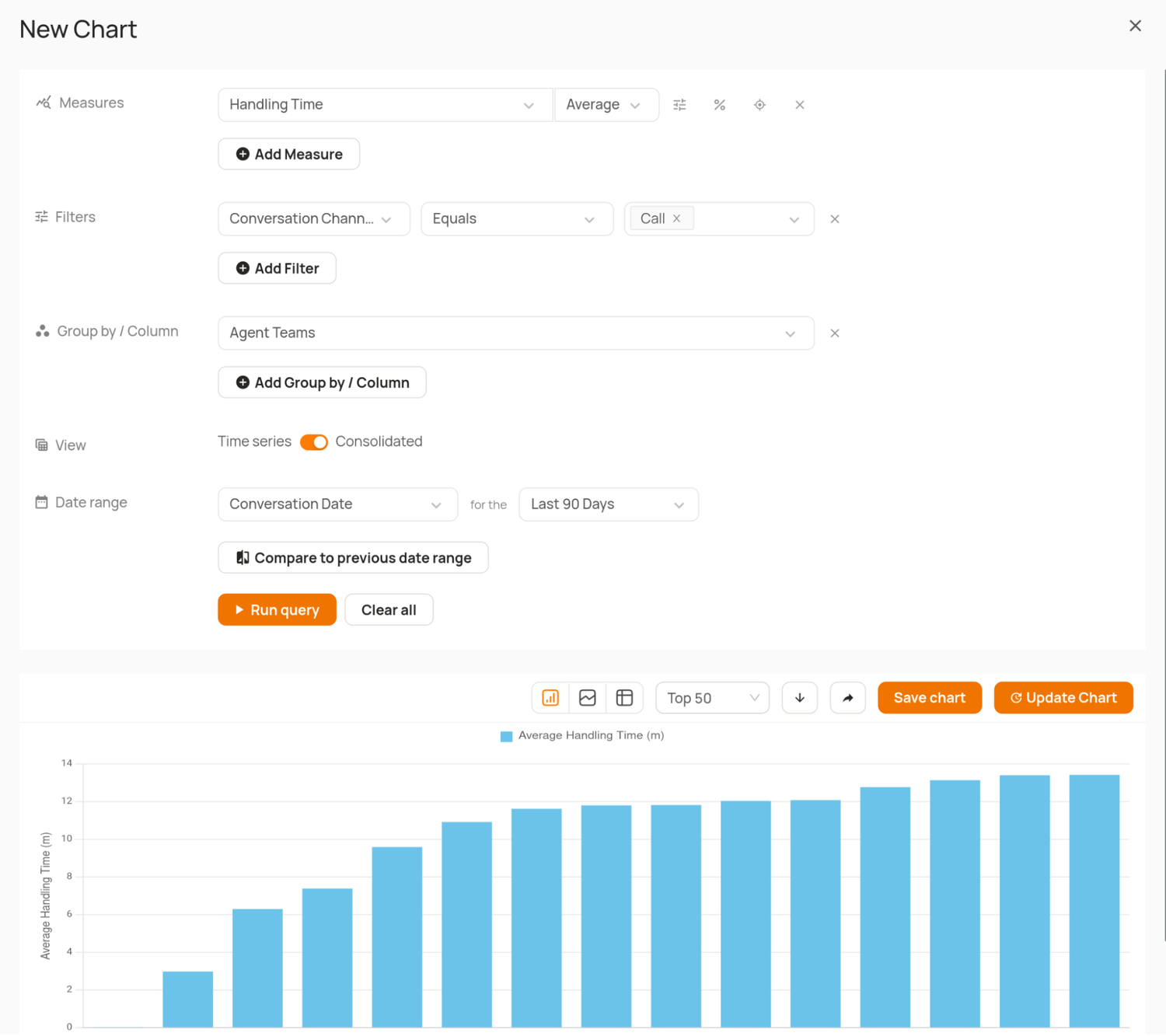
You can combine these with Level AI’s own data to ask questions such as:
- Which customer issues are being resolved the fastest and why?
- What are common characteristics of interactions that lead to upsells or cross-sells?
- How do different communication channels compare in terms of customer satisfaction?
- What impact do specific training programs have on agent performance metrics?
- Are there recurring themes in customer feedback that indicate potential product improvements?
You can only ask these types of questions if you utilize all your contact center’s data for reporting.
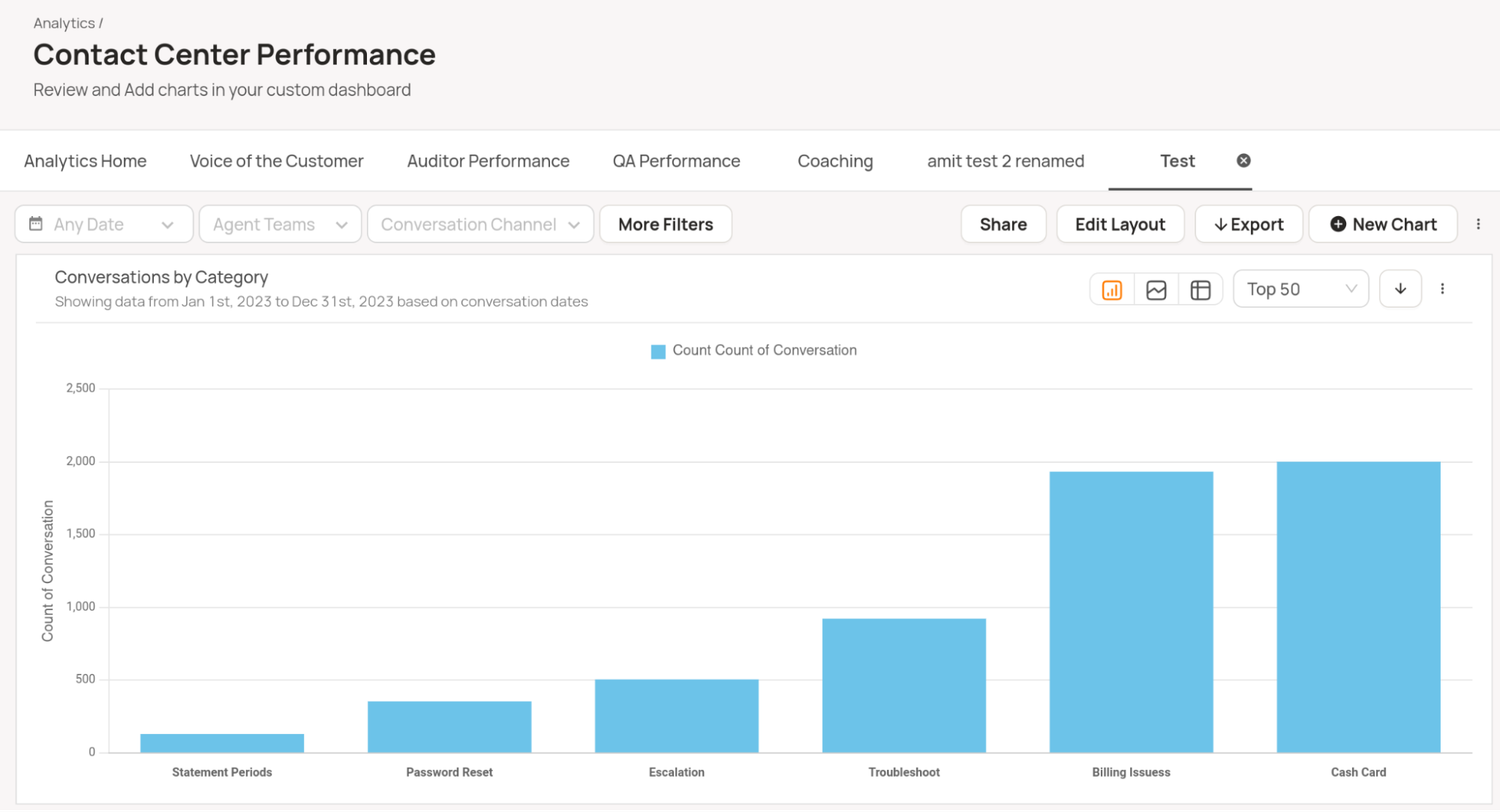
Any of Level AI’s data can be used in reporting, from conversation and sentiment tags to InstaScores, rubrics, etc.
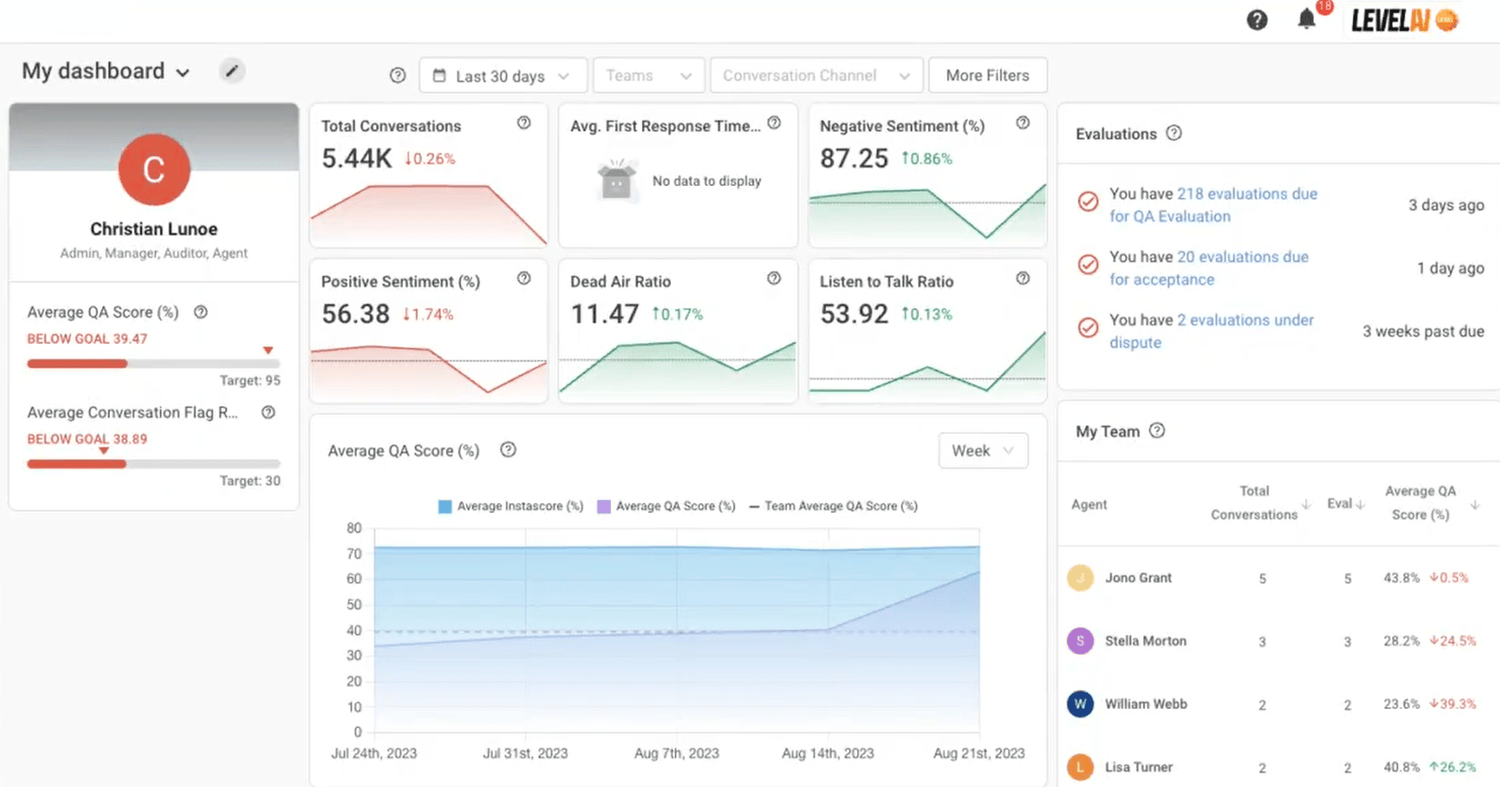
Our customizable system allows you to build and share dashboards with anyone in your organization, granting access based on roles or specific users.
Getting Started
We partner with contact centers across various industries, including real estate, finance, insurance, e-commerce, and more. Our AI-driven solutions enhance customer interactions, improve agent performance, and drive operational efficiency.
Level AI’s platform offers a comprehensive suite of features, from automated quality assurance to advanced speech and customer sentiment analysis, providing you with the tools needed to transform your contact center operations.
If you believe our Generative AI-powered solutions can benefit your organization, schedule a free demo to discover how Level AI can help you achieve your customer service goals.
2. CallMiner
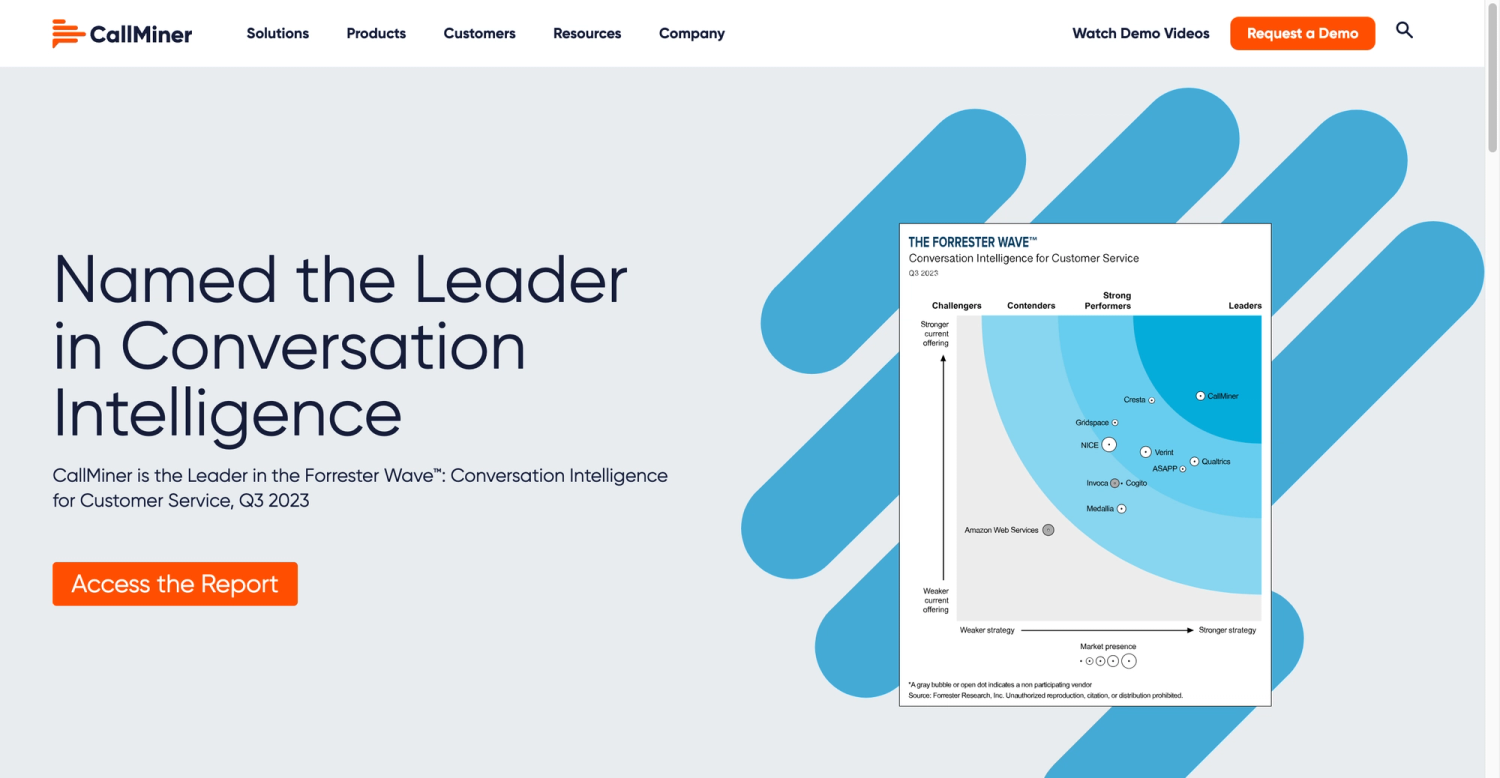
CallMiner provides omnichannel call center analytics software offering conversational metrics, speech analytics, and agent review features that save time for QA and frontline staff.
The platform’s Eureka product is a conversational analytics package that detects patterns and finds opportunities for improvement, like helping you reduce customer churn or optimize agents’ upselling skills.
Eureka offers several modules relating to call center analytics, including:
- Analyze — Analyzes customer conversations to uncover insights from all interactions. It uncovers trends and builds prediction models to improve call center effectiveness and efficiency, while providing customizable reporting.
- Coach — Provides statistical dashboards on agent performance, facilitates QA evaluations, and offers coaching workflows to encourage bidirectional engagement and visibility throughout the process.
- Screen Record — Records agents’ screens during customer interactions, providing insights into agent effectiveness and enabling synchronization between audio and video playback.
Pricing
CallMiner’s website doesn’t disclose pricing details and encourages prospective customers to sign up for a demo.
3. Nextiva
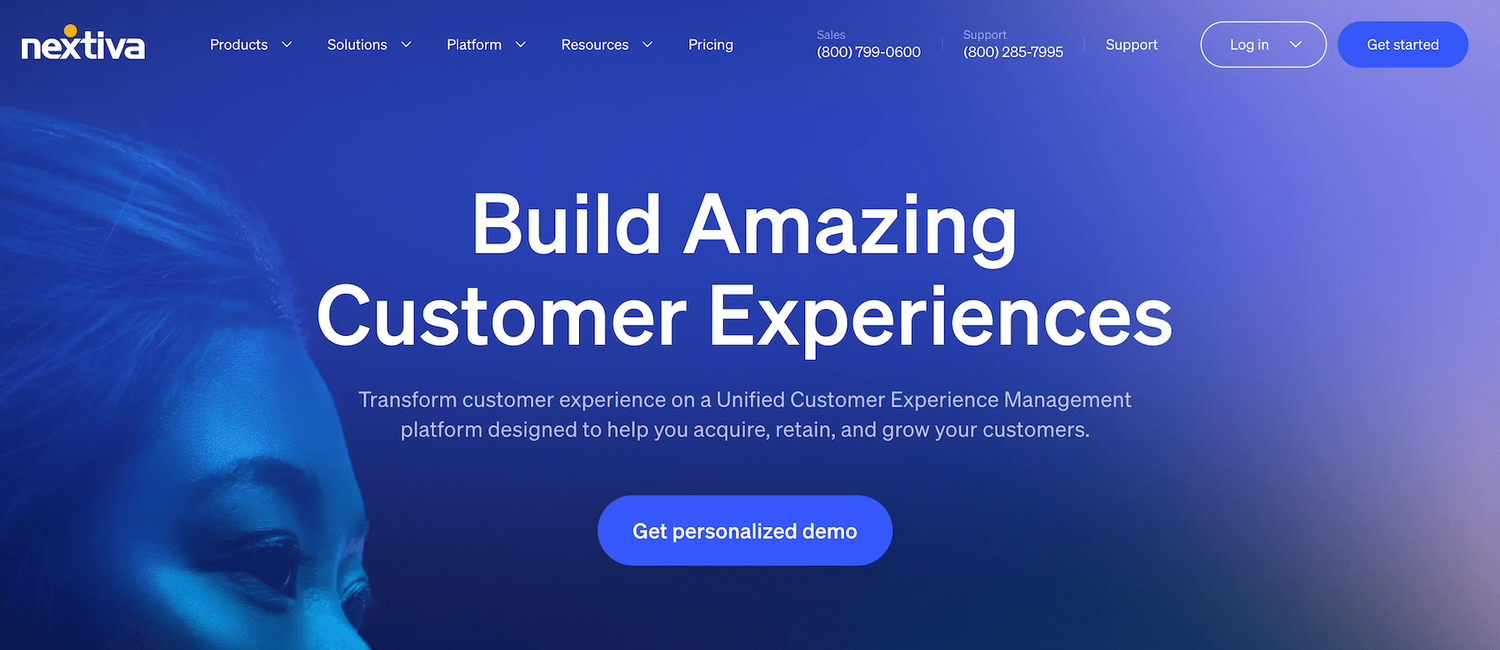
Nextiva is a customer experience platform that offers text analytics for call centers and sales campaigns. In addition to historical reporting on metrics and monitoring of call volumes and wait times, a key feature of Nextiva is its visual wallboards, which allow you to visualize data and trends.
Nextiva offers standard metrics like call time, handle time, speed of answer, number of outgoing calls, and number of incoming calls, which can be reported on to provide insights into customer behavior.
The platform’s dashboards are customizable, and links to these can be sent via email to other recipients.
Nextiva is HIPAA and SOC2-compliant and offers high dependability and call quality along with 24/7 support.
Pricing
The product offers three pricing tiers based on your team size and the number of features needed. The lowest tier costs approximately $20 per month with an annual plan, while the highest tier is priced around $32 per month with an annual subscription.
4. Qualtrics
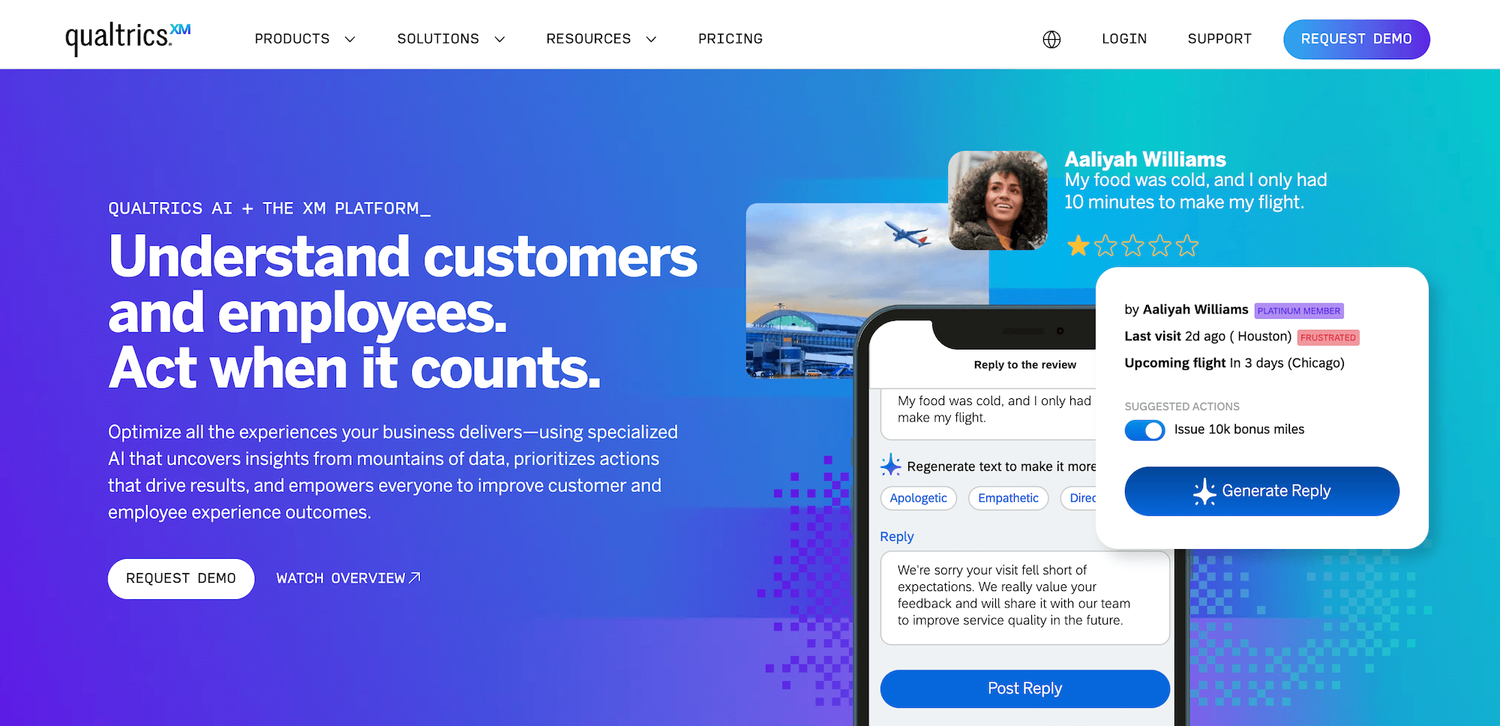
Qualtrics is an experience management software that offers call center analytics through its omnichannel analytics engine. The software parses customer interactions and uses natural language understanding to analyze causes of customer friction and churn, delivering insights into the customer journey.
The product supports over 20 languages and is tailored to recognize and analyze terminology from various industries.
It offers an extensive reporting module with integrations that allow you to segment customers via metrics like CSAT and specific behaviors such as mouse thrashing. It also incorporates generative AI to analyze high-volume data and identify risks and opportunities.
Pricing
Although their website doesn’t disclose pricing information, it does provide some guidance to the effect that the cost of the software will depend on which modules are requested, such as XM for Customer Experience, Employee Experience, and Strategy & Research.
5. CloudTalk

CloudTalk is a VoIP call phone system that provides call analytics to call centers and sales teams. Besides standard stats like CSAT, FCR, and AHT, it allows you to report on these for both individual agents and entire groups. Filters enable you to drill down into the data, uncovering customer trends and valuable insights into call center performance.
The platform offers four modules:
- Real-Time Dashboard — Displays stats for live customer interactions that show what both the customer and agent are saying.
- Agent Reporting — Provides accurate key performance indicators for individual agents so that you can improve coaching and deliver better customer service.
- Group Reporting — Gives call center managers full visibility on their team’s performance and allows them to drill down into reports to get a granular view of agents or calls.
- Wallboard — Integrates all your call analytics on a single LCD monitor to give visibility to both managers and agents. Examples of such KPIs are average wait times and number of callers on hold.
Pricing
As shown on their website, different pricing plans are available depending on the size of your team and sophistication of features. The basic plan starts at around $25 per user per month, while the highest plan is $50 per user per month (both billed annually).
6. Aircall
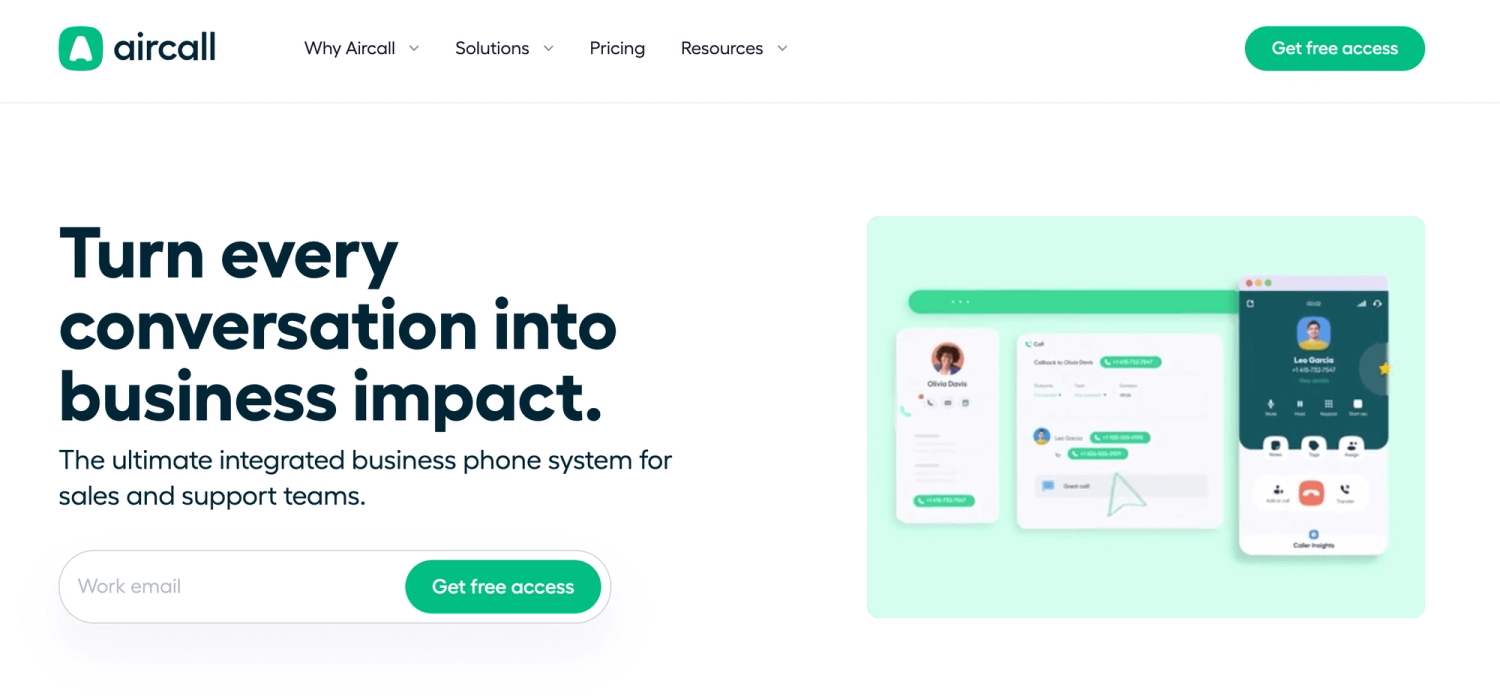
Aircall is a cloud-based phone system that offers call analytics capabilities for support and sales teams. It offers both historical and live dashboards, allowing you to compare agents’ performance across various call center metrics, such as unanswered calls by weekday and hour. The platform provides these stats and routing for both phone and SMS.
Aside from its call center features (e.g., call queues, ring groups, and activity feed), it helps you measure agent productivity, monitor trends in terms of key metrics and call tags across the entire organization, and identify when and why calls go unanswered.
Its extensive reporting functions provide the means for filtering data for digging deeper into patterns and offers customizable dashboards for user activity and unanswered calls.
Pricing
Aircall offers transparent pricing: $30 per license for three licenses, and a higher plan at $50 per license with additional features. Both plans are billed monthly at annual rates.
Unlock Strategic Insights from Your Call Center
Equip your team with a system that discerns and understands the underlying meanings behind spoken and written communication to drive business value and operational excellence.
Discover how advanced call center analytics software can improve your call center operations by scheduling a demo with the Level AI team.
Keep reading
View all

